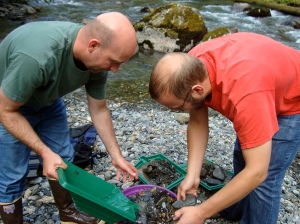 Metal detectors are an essential part of any plan to look for gold. There are many different kinds of metal detectors available on the market, at a wide range of price points, making shopping for a metal detector that will work for you a tricky proposition.
Metal detectors are an essential part of any plan to look for gold. There are many different kinds of metal detectors available on the market, at a wide range of price points, making shopping for a metal detector that will work for you a tricky proposition.
Before considering specific models of metal detectors, it is important to understand exactly how a metal detector works. They all work on the same basic principle, in that they feature a coil on the wand that becomes an electromagnet when the metal detector is turned on. The kind of gold you are planning to search for determines what specific kind of metal detector you need, as the ones required to find gold nuggets tend to be more expensive than those that would find buried jewelry.
There are two basic kinds of metal detectors. One is induction balance, also known as a VLF model. This version works by moving the energy up and down through the coil, which makes the machine more sensitive, triggering the discovery of smaller amounts of minerals than other detectors will.

The other kind of metal detector is a pulse induction, or PI, model. In these machines, the metal detector works by pushing pulses of energy through the coil in short bursts. They are less sensitive to small amounts of minerals than the induction balance detectors but can detect minerals that are deeper in the ground than the induction balance detectors.
The flagship metal detector for most serious gold-hunters is the Fisher Gold Bug 2. This highly powerful induction detector has a wide range of special features and coil sizes to make it versatile enough for any mineral searcher. Field tests indicate that this metal detector can find very small gold nuggets, down to half a gram, at a distance of 1.5 inches.
Another popular choice is the Goldmaster GMT, which is said to be the best in the VLF, or very low frequency, class. One unique feature of the Goldmaster GMT is the ability to “follow the streak” to track gold deposits more easily and effectively.
Simply buying a metal detector is not enough to make a person into a gold prospector. Metal detectors are valuable tools, that are best used in conjunction with traditional mineral finding techniques. Understanding the kind of rocks and mineral content in the soil of the area where you are prospecting, as well as the history of gold discovery in the area, is essential to know before you take your metal detector out to hunt for gold.
Gold metal detectors are not inexpensive items and extensive research into your needs is recommended before purchasing anything. However, having a good metal detector can make finding gold a feasible option for you.
For more information on beginning prospecting get the eBook !
!
 stories of the California Gold Rush in the mid-19th century. Prospectors from across the United States, and even across the world, headed for the West Coast in hopes of striking it rich. Some of them found their fortunes, others were not so lucky, but the thought of such an endeavor may be exciting enough to make 21st century folks wish it were 1848 all over again.
stories of the California Gold Rush in the mid-19th century. Prospectors from across the United States, and even across the world, headed for the West Coast in hopes of striking it rich. Some of them found their fortunes, others were not so lucky, but the thought of such an endeavor may be exciting enough to make 21st century folks wish it were 1848 all over again. ccessful in your endeavor to pan for gold you will need some basic equipment and some practice. The good news is that the equipment is fairly easy to get. As for the practice that is up to you. Here is list of basic equipment for the job.
ccessful in your endeavor to pan for gold you will need some basic equipment and some practice. The good news is that the equipment is fairly easy to get. As for the practice that is up to you. Here is list of basic equipment for the job. rush days the sluice box consisted of a simple wooden trough lined with raised obstructions placed at a ninety-degree angle to the flow of the water. These obstructions are what are known as riffels. When all of the gold carrying gravel is “run” through the sluice the water is shut off and the riffels are removed. The heavy materials containing the gold known as concentrates would be gathered. This run would sometimes consist of processing several tons of gold-bearing gravel through the box.
rush days the sluice box consisted of a simple wooden trough lined with raised obstructions placed at a ninety-degree angle to the flow of the water. These obstructions are what are known as riffels. When all of the gold carrying gravel is “run” through the sluice the water is shut off and the riffels are removed. The heavy materials containing the gold known as concentrates would be gathered. This run would sometimes consist of processing several tons of gold-bearing gravel through the box.